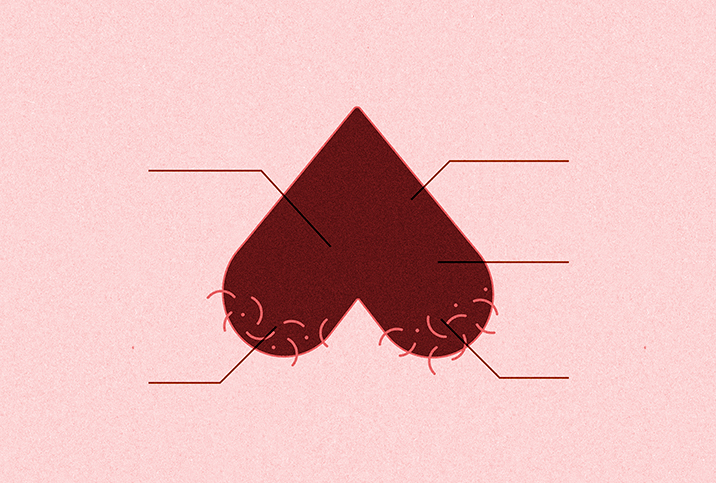6 Non-STI Reasons You Might See White Spots on Your Balls

Spots on your scrotum, no matter the color, are likely to get your attention. While they're unlikely to be whitish, you may be wondering why your scrotal sack has suddenly become marked. If they are white bumps on your balls, however, you may feel particularly concerned.
Pure white bumps on the testicles are rare, according to Janellen Smith, M.D., the director of oncodermatology at the University of California, Irvine, School of Medicine. They're not completely unheard of, though, either.
Blemishes, papules, plaques, lesions and macules on your genitals may appear white or partially white. Here are six conditions that aren't related to sexually transmitted infections (STIs) or sexually transmitted diseases (STDs) that could cause scrotal spots, whether they're perfectly benign and in no need of treatment or pathogenic and cause for concern.
1. Folliculitis
Folliculitis, or inflammation of the hair follicle—the small tunnel where hair emerges—can affect the scrotum, Smith explained.
"But it's more of a yellowy-white, right? So it's like a pus bump," she said, adding the head, or top, could be white. "But that would be less likely on the scrotum."
'Pure white bumps on the testicles are rare, [...] Blemishes, papules, plaques, lesions and macules on your genitals may appear white or partially white.'
If you wax, shave or pluck hair, that can cause folliculitis, according toAnthony Hall, a dermatologist with the Male Genital Dermatology Clinic of the Skin Health Institute in Melbourne, Australia.
2. Angiokeratoma of Fordyce
Common culprits that do not entail pathological disease are angiokeratomas of Fordyce, Hall said. Women might see these on the vulva, whereas men could find them on the scrotum.
"And angiokeratomas of Fordyce are dark red papules up to 2 or 3 millimeters, usually asymptomatic," he said. "They're totally innocent."
Approaches to treatment can include the use of a pulsed dye laser capable of decreasing the size of lesions and rapamycin, a generally well-tolerated topical drug.
Under certain conditions, these spots can appear whitish and, in rare cases, be a sign of something more medically dire.
"There is a very rare disease which produces angiokeratomas, [which] may just be confined to the scrotum or groin but [could be] more extensive, and that's calledFabry's disease," Hall said.
Also called Anderson-Fabry disease, this condition is a genetic disorder associated with high morbidity in patients.
"People who have Fabry's disease usually die early, predominantly with blood vessel abnormalities," Hall said.
3. Sebaceous glands
Hall said sebaceous glands at the base of scrotal hairs can occasionally cause white spots, but most men don't notice them. Sebaceous glands are the oil-secreting glands of your body and are sometimes called the oil glands.
"If you stretch your scrotum, you see there's often either a red or white small dot, only about 2 or 3 millimeters [at] most, and [those are] actually sebaceous glands," he said.
If ectopic oil glands become enlarged, they might be conspicuous, Smith said.
"People are supposed to have lots of oil glands everywhere, but sometimes they'll get some slightly enlarged ones in funny areas," Hall said. "One of the common spots to see them is actually in the mouth, so you can imagine that's probably not someplace you need to be really oily.
"So that's the word 'ectopic.' That means it's a normal feature but it's kind of in the wrong place, right? It doesn't mean you don't need oil glands on your scrotum, but sometimes they are a little bit bigger than [they] need to be, so somebody might notice those."
4. Cysts, steatocystoma multiplex and calcinosis scroti
"There are cysts that you can get on the scrotum; there's one called steatocystoma multiplex," Smith said, estimating they can be about a half-inch in size and could appear white in color. "A common area to see those is the chest, but it is not uncommon to see them on the scrotum as well."
Steatocystoma multiplex, frequently attributed to genetics, is characterized by numerous skin cysts that often develop during puberty.
Smith said men may see spots as a result of calcinosis scroti, which is potentially similar to cysts but rare enough that she said she sees it only once every couple of years. Also called scrotal calcinosis, the condition associated with calcified nodules within the scrotal skin is generally assumed to be benign.
Guys with scrotal calcinosis understandably ask for treatment.
"What we do is we just sort of painstakingly remove each one of them over time," Smith said. "I have a guy right now who's undergoing that. They're actually pretty easy [to remove]. You just put a little slit over them and they pop out, but I would not recommend that at home, just so you know."
Trained surgeons are better equipped. Ablative lasers and CO2 superpulsed laser treatment have been used as fast, effective alternatives to traditional surgery.
5. Scratching and lichen simplex chronicus
"Sometimes people get in the habit of scratching themselves down there," Smith said. "That's called lichen simplex chronicus."
The name derives from the chronic scratching that characterizes the relatively common itchy skin disorder. Tending to occur in mid-to-late adulthood, it thickens the skin, Smith explained. Though the marks are known to be darker in color, a patient could end up scratching the pigment enough that the marks on the skin begin to look white.
Medicines, including topical steroids, help interrupt the "itch-scratch cycle," Smith said.
6. Lichen sclerosus
Lichen sclerosus—one of the most common pathological diseases found on the male genitalia, according to Hall—can present as white plaques or lesions on the balls. This chronic inflammatory skin disease can be diagnosed clinically, with biopsies mostly reserved for certain cases. Potent topical steroids remain the gold standard for treatment.
Typically, lichen sclerosus can be initially treated with about half a gram—a fingertip-sized dose—of corticosteroid ointment (considered preferable to creams) once per day for about three months, according to a 2016 paper by Gudula Kirtschig, a consultant dermatologist whose research has contributed to more than 80 peer-reviewed scientific papers. Topical calcineurin inhibitors are an effective and likely low-risk second line of treatment, Kirtschig noted in the review paper. In complicated cases, physicians resort to surgery.


















